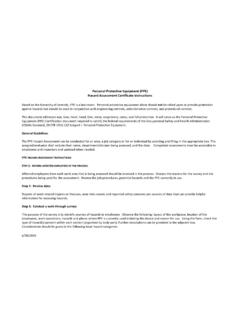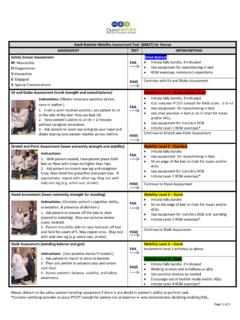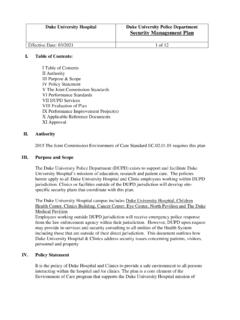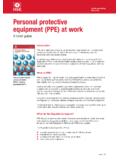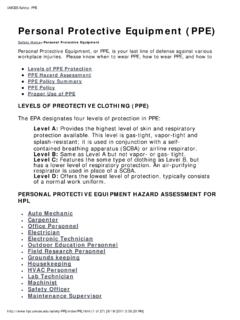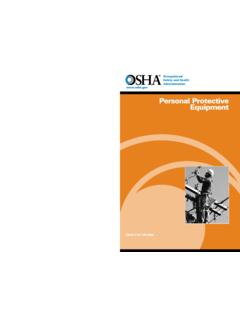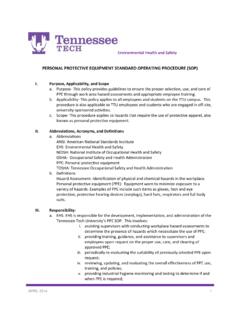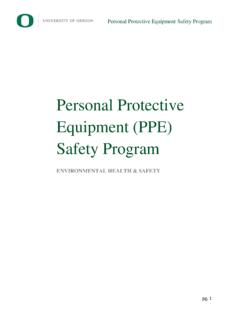Transcription of Personal Protective Equipment Policy - Duke University
1 SECTION II. General Safety and Health Chapter 1. Personal Protective Equipment Revision Date 7/28/16 Personal Protective Equipment INTRODUCTION PURPOSE Whenever feasible, hazards must be eliminated through engineering, and/or administrative controls, prior to resorting to the use of PPE. In some work environments Personal Protective Equipment (PPE) must be provided and used to protect personnel against hazards capable of causing injury, illness, or impairment. It is the Policy of Duke University to provide appropriate PPE to employees who may be subjected to a hazardous environmental condition. RESPONSIBILITIES Departments shall: Conduct PPE Hazard Assessments that identify when, where and what PPE is required. Provide appropriate Personal Protective Equipment and training to employees exposed to hazards requiring PPE.
2 Post areas requiring PPE with appropriate caution signs. These areas include eye, face, head, hearing, and hand protection areas. Ensure that employees use PPE appropriately when required Supervisors shall: Ensure that PPE Hazard Assessments are conducted when appropriate. Ensure that appropriate PPE is available to employees. Ensure that PPE is used properly where it is required. Employees shall: Use PPE in accordance with instructions and training received. Care for their Personal Protective Equipment properly and guard against damage and contamination. Report PPE malfunctions or problems to supervisory personnel. OESO shall: Assist departments and supervisors with their departmental Personal Protective Equipment programs. Assist departments in conducting PPE Hazard Assessments.
3 Assist departments in determining appropriate PPE for specified hazards. Review departmental procedures and/or policies to ensure compliance with regulatory requirements. PROCEDURES GENERAL PPE will be provided and used in the following circumstances: Where it has been determined that adequate engineering, and/or administrative controls do not reduce exposure potential to a safe level. Where development or installation of engineering controls are pending. Where it has been determined that PPE is necessary to protect the health and safety of employees. During short term, non-routine operations for which engineering controls are not practical. During emergency situations such as spills, ventilation malfunctions, damage control, activities, etc. PPE HAZARD ASSESSMENT CERTIFICATION REQUIREMENTS PPE Hazard Assessments are necessary to determine if hazards are likely to be present in the workplace which necessitates the use of PPE.
4 Appropriate PPE is then selected and required for use by each affected employee as protection from the identified hazards. This process must be verified through a written certification that identifies the workplace evaluated, the person certifying that the evaluation has been performed, the date(s) of the hazard assessment, and the document as a certification of hazard assessment. The workplace will be reassessed as necessary. CONDUCTING A PPE HAZARD ASSESSMENT A PPE Hazard Assessment Certificate can be filled out for a specific worksite area, job position or an individual. Such a certificate (with instructions) is available on the OESO website ( ) Forms page and can be found in the supplement to this manual entitled PPE Hazard Assessment Certificate . Input from affected employees is recommended when identifying the hazards.
5 This form is for the purpose of identifying workplace hazards and the correct PPE to be worn. If a more comprehensive Job Hazard Analysis (JHA) has been completed or is planned, which will cover PPE requirements, that process can serve as the PPE Hazard Assessment. USE OF PPE A guideline for PPE selection in various hazardous situations can be found in the supplement to this manual entitled PPE Selection Guidelines and Quick Reference Guide . The supplement is intended for use as a quick reference and should be used in conjunction with the applicable parts of this chapter. There may be operating conditions in which the use of a listed item from the supplement is impractical or would increase the hazard. In these instances, use appropriate PPE and procedures to safeguard employee safety and health.
6 PROCUREMENT OF PPE In general, cost of PPE is borne by the department. Where Equipment is very Personal in nature and is usable by workers off the job, departments have the flexibility to decide what portion of the cost they will bear. Examples of PPE that is Personal in nature and often used away from the worksite include prescription safety glasses and safety shoes. STORAGE OF PPE PPE shall be properly stored to protect against environmental conditions that might reduce the effectiveness of the Equipment or result in contamination during storage. PPE having a shelf-life limitation shall be checked periodically to ensure compliance with the expiration date. MAINTENANCE OF PPE PPE, including employee-owned PPE, shall be maintained in a sanitary and serviceable condition. PPE requiring specialized servicing as specified by the manufacturer shall be serviced by qualified personnel.
7 PPE issued for exclusive use by an individual employee shall be visually inspected for defects or wear by the employee before each use. Such PPE shall be inspected frequently by the supervisor to ensure its serviceability. PPE subject to use by more than one individual, such as visitor's PPE or PPE used only occasionally, shall be cleaned and disinfected by the last individual to use it, before being made available for use by subsequent personnel. Where disinfection of PPE is not applicable ( , thermal gloves, leather gloves, etc.), it is recommended to wash hands or use hand sanitizer before and after use. PPE intended for emergency use shall be cleaned, disinfected, and placed in an operable condition after each use by the last individual to use it. Such Equipment shall be inspected monthly to ensure its serviceable condition.
8 Records shall be kept of these inspections. TRAINING For employees required to wear PPE, training will include: Explanations on when PPE is necessary and what PPE is required for specified tasks. Instructions for proper use of PPE. The limitations of the selected PPE. The proper care, maintenance, useful life and disposal of the PPE. REFERENCES Code of Federal Regulations, Title 29 (OSHA) 1910 Subpart I, Personal Protective Equipment Personal Protective Equipment 1926 Subpart E, Personal Protective and Life Saving Equipment 1926 Subpart M, Fall Protection
